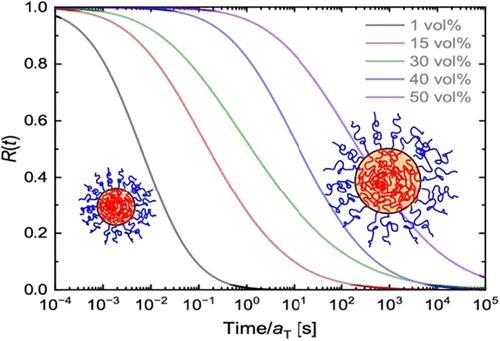嵌段共聚物胶束溶液中链交换动力学的浓度驱动减速
IF 5.2
1区 化学
Q1 POLYMER SCIENCE
引用次数: 0
摘要
我们研究了聚苯乙烯-b-聚(乙烯-丙烯-丙烯)(SEP)二嵌段共聚物(Mn = 75 kDa, Đ = 1.05, fPS = 0.18)在聚乙烯选择性溶剂角鲨烷中制备球形胶束的链交换动力学与聚合物浓度的关系。小角度x射线散射证实,浓度为15vol %或更高的溶液采用体心立方(BCC)胶束填充,或致密的液体状填充(LLP)。同时,胶束的平均聚集数稳定增长,从稀溶液中的约60个增加到近200个,增加了50 vol %。时间分辨小角中子散射(TR-SANS)分析显示,当聚合物浓度从1 vol %增加到50 vol %时,链交换率单调而显著(即超过4个数量级)下降。分析了TR-SANS弛豫函数,同时考虑了对比度的变化(由于链交换)和结构因子的演变(由于胶束堆积的细化)。利用已建立的模型提取链抽离活化能,并将其表示为聚合物浓度的线性函数,这表明,除了抽离核心区块的焓势垒外,胶束特性随浓度的增加的演变对链交换有进一步的约束。与Halperin理论一致,这些结果表明,由于聚集数的增加,每个链的界面面积减少和相关的电晕拥挤增加,这些主要因素反映了岩心块拉出过程中的空间惩罚。交换速率与胶束是否采用BCC或LLP排列无关,这证实了限速步骤是提取核心区块。本文章由计算机程序翻译,如有差异,请以英文原文为准。

Concentration-Driven Slowdown of Chain-Exchange Kinetics in Block Copolymer Micelle Solutions
We investigate the dependence of chain-exchange kinetics on polymer concentration for spherical micelles prepared from a polystyrene-b-poly(ethylene-alt-propylene) (SEP) diblock copolymer (Mn = 75 kDa, Đ = 1.05, and fPS = 0.18) in the PEP-selective solvent squalane. Solutions with concentrations of 15 vol % or more adopt a body-centered-cubic (BCC) packing of micelles, or a dense liquid-like packing (LLP), as confirmed by small-angle X-ray scattering. Concurrently, the mean aggregation number of the micelles grows steadily from about 60 in dilute solution to nearly 200 by 50 vol %. Time-resolved small-angle neutron scattering (TR-SANS) analysis reveals a monotonic and substantial (i.e., more than 4 orders of magnitude) decrease in the rate of chain exchange as the polymer concentration increases from 1 to 50 vol %. The TR-SANS relaxation functions are analyzed, taking into account both changes in contrast (due to chain exchange) and evolution in the structure factor (due to refinement of micelle packing). The activation energy for chain pullout is extracted using an established model and can be expressed as a linear function of polymer concentration, indicating that, in addition to the enthalpic barrier for extracting the core block, the evolution of micelle characteristics with increasing concentration imposes further constraints on chain exchange. Consistent with a theory of Halperin, these results suggest that the dominant factor reflects steric penalties during core block pullout arising from a reduced interfacial area per chain and associated increased corona crowding, due to the increase in aggregation number. The rate of exchange is independent of whether the micelles adopt a BCC or LLP arrangement, confirming that the rate-limiting step is extraction of the core block.
求助全文
通过发布文献求助,成功后即可免费获取论文全文。
去求助
来源期刊

Macromolecules
工程技术-高分子科学
CiteScore
9.30
自引率
16.40%
发文量
942
审稿时长
2 months
期刊介绍:
Macromolecules publishes original, fundamental, and impactful research on all aspects of polymer science. Topics of interest include synthesis (e.g., controlled polymerizations, polymerization catalysis, post polymerization modification, new monomer structures and polymer architectures, and polymerization mechanisms/kinetics analysis); phase behavior, thermodynamics, dynamic, and ordering/disordering phenomena (e.g., self-assembly, gelation, crystallization, solution/melt/solid-state characteristics); structure and properties (e.g., mechanical and rheological properties, surface/interfacial characteristics, electronic and transport properties); new state of the art characterization (e.g., spectroscopy, scattering, microscopy, rheology), simulation (e.g., Monte Carlo, molecular dynamics, multi-scale/coarse-grained modeling), and theoretical methods. Renewable/sustainable polymers, polymer networks, responsive polymers, electro-, magneto- and opto-active macromolecules, inorganic polymers, charge-transporting polymers (ion-containing, semiconducting, and conducting), nanostructured polymers, and polymer composites are also of interest. Typical papers published in Macromolecules showcase important and innovative concepts, experimental methods/observations, and theoretical/computational approaches that demonstrate a fundamental advance in the understanding of polymers.
 求助内容:
求助内容: 应助结果提醒方式:
应助结果提醒方式:


